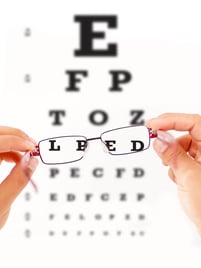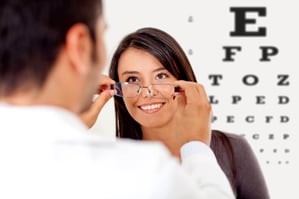How To Select The Proper Base Curve

While the subject of base curves comes up multiple times a day in my discussions with our customers, I have avoided writing about it for years for three reasons:
- It is a complex topic that confuses many.
- It is not seen as important to others.
- It gets misunderstood by the majority of the rest.
Similar to religion and politics, it's a subject that can destroy friendships. The correct base curve is always a battle of which of 3-key factors is the most important: optics, fit, or cosmetics. But, it does not have to be this way.

To put it in a nutshell, all three are important in their own way.
Good look, good fit, poor optics = problem
Great optics, solid fit, big bubble eyes because of magnification = problem
Good looks, great optics, and lenses fall out of the frame = problem
Sorry Meatloaf, but in this case, 2 out of 3 can be very bad!
For the select few who have kept reading this far, I know what you’re thinking. Where do I prioritize? Which of the 3 is most important? The answer is simple, D, all the above.
To help with understanding this better, we will break down the three areas and then we will look into the importance of keeping them all as a priority when fitting a patient with new lenses.
Optics 
To get a total grasp of the optics you have to begin with a general understanding of how the eye works. The total field of view of the human eye is 160 degrees – central plus peripheral. The central vision, which gives us our detailed or sharp vision, is about 2 degrees. The human eye will resist rotating at much more than a 15-degree angle to scan an object. Any further than that, then head movement will be needed.
While 15 degrees does not sound like much, it's what we're used to. What we do know is that the human eye is close to a 6 base curve. To give eyeglass wearers close to the same range of vision, the backside of an optical lens should be close to a 6 base curve. Much flatter or steeper will affect the field of view and result in more head-turning.
This is what lens manufacturers use to figure their base curve recommendations. For the optical lab folks and lens manufacturers, optics are the highest priority.
Fit 
This is pretty straightforward. Your patient has purchased an expensive frame and is expecting a pair of lenses to fit properly in it. To ensure proper fit, you have three options, and only one of them is correct:
- Hope that the base curve will work with the frame = incorrect
- Request a base curve that matches the frame that was chosen and hope the optics are okay = incorrect
- Before helping a patient choose a frame, take time to figure out the proper base curve, then pick a frame that will work with Rx = correct
Figuring out the proper base curve based upon Rx is fairly simple:
Plus Power – Use the Spherical Equivalent (Sphere power plus half the cylinder power) and add 4.00 diopter to that. Example – Rx of +2.50, the base curve will be approximately 6.50.
Rx +2.50Sph -> [+2.50 + 4.00D] = 6.50BC
When working with digital freeform progressives, you also need to include the add power in the Spherical Equivalent figure.
Minus Power – Take half the Spherical Equivalent and add 4 diopters to that. For example – a job with a -4.00 SE you would use -2.00 + +4.00 which would give you a 2BC.
Rx -4.00Sph -> [(-4.00 x .50) +4.00] = 2.00BC
Knowing the base curve ahead of time will help you choose the appropriate frame for your patient, cutting down on remakes and reframing.
Cosmetics 
Here is where the rubber meets the road. Every eyeglass sale is based upon looks. In the six years that I dispensed, I have never had a patient choose a frame without first looking at themselves in the mirror. I know some patients make it look easy. They try on 2 or 3 frames and call it a day. It does happen but is not the norm.
If I polled our customer base, asking which of the 3 was most important, I believe cosmetics would win. I know that is how I would vote.
Here is the thing. A patient comes in with an Rx of +5.00. We now know for best optics this job should be on at least an 8BC. You also know that this will limit frame choices and also can cause some serious magnification giving them a bug-eyed look.
At this point, you have a choice to make, either go for the best optics and maybe have to refund or remake the job in the end because of bad cosmetics.
Here is where you need to find a balance. The best optics would be in an 8BC and the best cosmetics would be in a 5BC. Find a happy place in between with a 6.50BC. This should keep the optics good while giving your patient a fantastic-looking pair of glasses.
Closing tips:
Specify your base curve when ordering from your lab. Lab programs are often based upon the best optics and do not take fit and cosmetics in mind. IcareLabs highly recommends the ECP to give us a base curve on both uncut and finish work. We do not charge extra for this.
Make sure to take the time to look over the patient’s Rx before starting to look for frames. Be open about the challenges their Rx brings if there are any. Don’t let the -5.00 guy fall in love with an 8 base wrap frame. That will only bring trouble.

